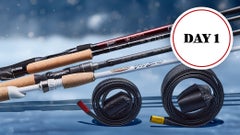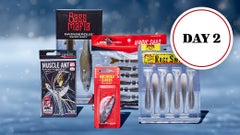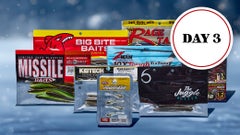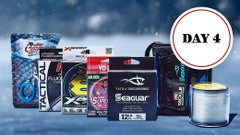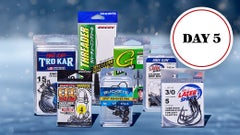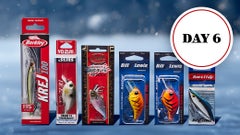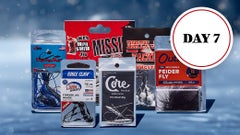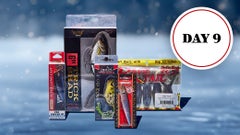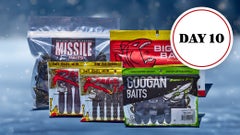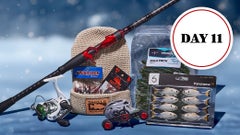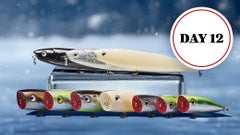Edwin Evers Wins Bass Pro Tour Championship Redcrest
Edwin Evers' Winning Pattern, Baits & Gear
Prior to arriving in La Crosse, Wis., for the start of the Bass Pro Tour Redcrest, Edwin Evers liked how his skillset matched up with the challenges he was likely to face on the upper Mississippi River. As one of the most versatile and experienced anglers in the 30-man field, there wasn't much the river could throw at him that he hadn't already seen before, either there or on other river systems. Remember, he posted Elite Series victories on the Alabama River, the St. Johns River, the St. Lawrence River, the Tennessee River (Kentucky Lake) and also claimed the 2016 Bassmaster Classic title at Grand Lake with a massive final-day bag caught out of the Elk River. The man flat out understands how bass behave around current. Momentum was on his side, too, as he was coming off a season that saw him claim a Stage victory (Lake Conroe) and the first points championship of his pro career. "I was pretty excited about it," Evers said. "I feel comfortable fishing the river there. Maybe my record doesn't show it, but it's a place I've always liked."
His record in events out of La Crosse wasn't all that bad actually. In four Elite Series tournaments, his average finish was 35th. Included among those were two top-12s and a top-40 showing. His worst finish (86th) came last year when the river level was on the rise after a heavy rainfall immediately before the tournament. While he was most excited about the prospect of fishing the Championship Round on Pool 7, where he had a good bit of experience and some unfinished business, he had to get there first and that involved surviving the qualifying rounds on Pool 8. Here's a rundown of how he survived and advanced through the Elimination and Knockout rounds before lapping the field with a Championship Round for the ages.
Practice:
With Pool 8 serving as the venue for the qualifying rounds leading up to the Championship Round, which took place on Pool 7, Evers put an emphasis on finding places with concentrations of bass. Low water levels drew fish out of the cover they'd been inhabiting and put them in much more predictable locations. Current, as it always is, was also a major factor in positioning the fish. "I approached practice to find groups of fish," he said. "From my past experience on rivers and there in particular, there are always places where they group up. It might be four of them or 20, but they're always grouped up. I focused on points, tails of islands, wing dams - anywhere they would group up." He said the start of practice was slow, but once he began throwing the Berkley Frittside crankbait, the puzzle started coming together.
"I caught one everywhere I stopped on it," he said of the recently introduced flat-sided plug that dives to five feet with relative ease. "The combination of that bait and fishing points, when I'd catch one, there'd be multiple fish or I'd catch two. There were always groups of them." He estimates about 70 percent of the bass he caught in practice were smallmouth. "I was ready for the tournament to start after day one. It was something about that flat-sided bait that drew those fish out," he added.
Competition:
The Shotgun Round last Wednesday didn't unfold how Evers thought it would. He caught a few fish in the first hour, then went roughly three hours until his next bass came in the boat. Other than a handful of fish caught on a shaky-head, the crankbait accounted for the bulk of his weight. "The best group of fish I found, I only caught a handful there and the other groups were community holes," he said. "I rotated through some of that stuff and some bridges and it was one here, one there. It was a lot harder in the initial rounds than I thought it would. I thought I'd catch a lot more fish." Still, he managed to catch 26 that weighed 40-03 and had him in 16th place out of 30. The Elimination Round was not as much of a grind and as the day wore one, he felt comfortable about catching enough to finish in the mid-teens, securing a spot in the Knockout Round. "It was quite a bit easier," he said. "I felt like I could stay in 14th or 15th and stay in there. I wanted to make sure I fished Friday. That was part of my strategy."
His reasoning there was he didn't want to contend with the weekend boat traffic. "I wanted to get right back out there because you don't know how hard something is going to get pounded," he said. "When you're out there, you can see what's getting fished and what's getting a break. Plus, my family was going to be in town Saturday and I wanted to spend time with them." He boated 24 fish for 36-15, which put him in 15th place and slotted to fish the first Knockout Round on Friday. The Knockout Round produced his highest fish catch total and best weight of the first three days, but it was no easy chore nailing down a spot in the top 5. He was seventh after the first period and sixth after the second, but had his best period of the day in the third with 12 bass for 16-15. It was enough to fend off Stephen Browning to claim one of the 10 spots in the final. "I had a spot I was saving and the first two times I fished through it, it didn't produce," he said. "I went back a third time and caught what I needed. It was a nerve-wracking day. Until you experience it, it's hard to describe it in words."
On Saturday morning, he spent four hours exploring Pool 7. Knockout Round qualifiers were allowed to drive around, but fishing was not allowed. Evers used the time to check old haunts, but there was one area in particular he was curious about. It turned out to be the place that produced his prodigious third-period flurry during the Championship Round. "I just didn't want to get stuck," he said. "I found stuff I really liked and found spots where I'd caught fish in the past that was current related. I felt like there would be fish on the same stuff. I tried to get into that backwater and once I got in there it didn't look awesome. In the past, it was matted and hard to fish, but it worked out that it wasn't matted and open down the middle because that meant the fish had to relate to the wood that was left in there." When he woke up Sunday morning, Evers said he made the decision to start in an area on Pool 7 that he'd fished before, but have never truly tapped into its potential. "It's crazy because I've had a 25-pound bag in practice shaking 'em off in there," he said. "I had big fish out of there (in 2016) with a 5-06. I've caught 6s in there in practice. I've seen them because generally, it's so clear you can see all across it."
It was reminiscent of the area he won out of at Conroe - a secluded section of the fishery that he had all to himself. "It's important to maximize your time and put the trolling motor down and produce bites, and not run around," he said. "Any time spent running around you can be falling behind on the ScoreTracker." One element was different this time around in that he noted a few more blowdowns had made their way into the water and that only worked to his advantage. "I had some areas where I knew some fish lived, but it was a matter of getting in there and figuring out how to catch them," he said. "Fortunately, the first area was all I needed and it worked out."
He spent the early part of the day picking over wood by pitching a Berkley Pit Boss. He piled up 22 bass in the first period. His closest challenger, Greg Hackney, caught nine. The second period was his slowest with only eight fish posted on the ledger. Hackney closed the gap to under six pounds, but a late-period surge put Evers comfortably ahead entering the final 2 1/2-hour period. That's when he began casting toward a spot where an old beaver dam used to be. Evidently, a few dozen bass had taken up residency because Evers plucked almost every one of them out of there with a vibrating jig. It was like watching the first catch on a loop - he'd make a cast, engage the reel, crank the handle three to four times then set the hook, land the fish, clip it to the scale and release it. For a half hour, the bass came into the boat at such a frenzied pace the boat official wasn't able to enter them into the ScoreTracker system until later. What was already a healthy advantage turned into a runaway and Evers had the second $300,000 payday of his career. The win capped off a remarkable season in a tournament circuit that didn't exist a year ago. "The last year flew by," Evers said. "It was a whirlwind. It's amazing that, heck, eight months ago we all signed a deal to start a new league. It's amazing it came together in such a short amount of time."
Winning Gear:
Crankbait gear: 7' medium-heavy Crankin' Stick casting rod, Johnny Morris Platinum Signature casting reel (8.3:1 ratio), 12-pound fluorocarbon line, Berkley Frittside crankbait size 5 (honey shad).
Shaky head gear: 7'1" medium-action spinning rod, Johnny Morris Platinum Signature spinning reel, 20-pound braided line, 8-pound fluorocarbon line (leader), 1/8- and 3/16-oz. unnamed shaky-head jig, 6" Berkley PowerBait Bottom Hopper (green-pumpkin).
Topwater gear: 6'9" medium-action casting rod, same reel as crankbait, 50-pound braided line, Berkley J-Walker 100 (bone).
He also caught a few fish during the early rounds on a Berkley PowerBait Power Jerk Shad.
Vibrating jig gear: 7'1" medium-heavy Platinum Signature casting rod, same reel as crankbait, 1/2-oz. Z-Man Evergreen Jackhammer ChatterBait (chartreuse/white), 3.5" Berkley PowerBait The Deal trailer (white).
Flipping/pitching gear: 7'6" heavy-action casting rod, same reel as crankbait, 20-pound fluorocarbon line, 3/8-oz. tungsten worm weight, 3/0 Berkley Fusion19 Heavy Cover hook, Berkley PowerBait Pit Boss (California 420).
MLF/Bass Pro Tour Redcrest Winning Pattern BassFan 8/27/19 (Todd Ceisner)
Greg Hackney's Pattern, Baits & Gear
Greg Hackney said he had to modify his mindset for Redcrest compared to previous trips to the upper Mississippi River. It didn't take him all that long to get that done. "Every time I've been here before, I've always caught individual fish because we were fishing for five," he said. "I spent all practice fishing for schools, and I found four or five different places that I felt brought 15 bass to the plate. It got better each day and I felt like I got better, too." What was unique about how Hackney fished Redcrest was that he had a crankbait in his hand most of the time on Pool 8. He located schools in shallow water and also deeper. "I didn't bring a bunch of plugs, but I graphed them and they got deeper each day," he said. "I had schools in three feet and my best two places they were in 12 to 15 feet."
After posting a solid showing in the Shotgun Round, he got more clued in during the Ellimination Round, when he finished ninth to sew up a spot in the Knockout Round. "That's when I figured out the 5XD and that helped my chances to make the top 10," he said. "I figured out the lineups and angles and having the day off (between the Elimination Round and Knockout Round) was perfect. It allowed those schools to bunch back up." He was able to be efficient during the second Knockout Round as he piled up 71-11. "I went to the sweet spots each time," he said. "I didn't have to fish in between."
In the Championship Round, he chose to fish an area that he recalled having a strong population of bass from his previous visits to the area. He just couldn't keep pace with Evers. "Even Sunday, I felt like I was getting better," he said. "The more days you spend on the water, between the two days' of practice and four days' of the tournament, the better you get. The days on the water helped. I felt like I moved well and made good decisions. It just wasn't in my cards (to win)."
Gear:
Cranking gear: 7' medium-action Lew's Custom Pro Hack Attack Speed Stick cranking rod, Lew's BB1 Pro Speed Spool Series casting reel (6.8:1 ratio), 14-pound Gamma Edge fluorocarbon line, Strike King KVD 1.5 square-bill crankbait (black back chartreuse), Strike King Pro Model 5XD crankbait (chartreuse perch).
He favored the chartreuse perch color for deeper water due to the tannic hue of the water where he was fishing.
When the crankbait bite tailed off, he followed up with a Texas-rigged Strike King Rage Cut-R Worm (junebug).
In the Championship Round, he relied on a 3/8-oz. Strike King Hack Attack Heavy Cover swim jig (black/blue and white) tipped with a matching Strike King Rage Rage Craw in the morning. In the afternoon, when conditions got cloudy and warm, he went with a 3/8-oz. Strike King Hack Attack Select Buzzbait (black and white) with a Rage Craw threaded on as a trailer.
MLF/BPT Tour RedCrest 2-5 Patterns BassFan 8/29/19 (Todd Ceisner)
Greg Vinson's Pattern, Baits & Gear
Reaction baits were the central player for Greg Vinson's impressive showing last week. He located several areas holding a concentration of fish and played the strategy game to perfection, meaning he made sure to not be seen doing the same thing in similar places too often. "Day one of practice was unbelievable," he said. "I got dialed into what I was looking for and credit my Garmin mapping. Once I got bites on two or three places, I picked up on the consistency and it got predictable. I knew it would be important to protect that, especially during early rounds. I knew not to run straight to places with similar features." He said he experienced some "scary moments" during the Elimination and Knockout rounds related to when he pulled off certain areas, but it wound up paying off for him.
"I felt like I was laying off some early on and trying to protect them," he said. "There were a bunch of anglers up in the grass and I was out on the edges. It's what you do in Wisconsin. You swim a jig, frog or flip. There were a lot of fish on the outer edges (of grass) with the lower water." And that's where Vinson did the bulk of his damage. Areas with submerged eelgrass and coontail were the best producers. He also fished hard cover and riprap near bridges and causeways. "They'd school in the grass chasing bait, but from what I could tell, they were staging and then run in and feed on shad," he said. "It was all about the baitfish. Some of those places were stocked full of shad. If you could find the shad you'd find the fish close by."
His approach to the schooling fish took some thought and planning. "They'd move into the holes in the grass and over time I figured those fish would sit there and move into the holes waiting for shad to come by," he said. "It was frustrating throwing treble hooks into the eelgrass. I tried jigs, frogs and plastics and they would nip at it, but they've seen those so many times. With the topwater, they would crush it after a few pops." In the Championship Round on Pool 7, he saw plenty of areas that had the potential to hold fish based on how fished in Pool 8, but he opted to fish near the tail race below the dam separating pools 6 and 7. "I fished wing dams and current breaks," he said. "I caught them in groups of three or four, but I needed groups of 20. I made a good move, though, that was worth $18,000. I don't anybody that wouldn't be proud of that."
Gear:
Jerkbait gear: 7'2" medium-action homemade MHX casting rod, Shimano Chronarch G casting reel, 15-pound Seaguar InvizX fluorocarbon line, unnamed 110-size jerkbait (white).
Vinson swapped the hooks on his jerkbait for #5 Owner STX trebles.
He opted for bigger line than normal because he wanted to keep the bait up higher in the water column, allowing the fish to come get the bait above the submerged grass.
Topwater gear: 7'6" heavy-action homemade MHX cranking rod, Shimano Metanium MGL casting reel (6.3:1 ratio), 40-pound Seaguar Smackdown braided line, Strike King Sexy Dawg (bone).
He opted for braid for added confidence when hauling bass back to the boat through and over the grass. The big rod also allowed him to make long casts, when necessary, to reach school fish.
MLF/BPT Tour RedCrest 2-5 Patterns BassFan 8/29/19 (Todd Ceisner)
Zack Birge's Pattern, Baits & Gear
Reaction baits were the central player for Greg Vinson's impressive showing last week. He located several areas holding a concentration of fish and played the strategy game to perfection, meaning he made sure to not be seen doing the same thing in similar places too often. "Day one of practice was unbelievable," he said. "I got dialed into what I was looking for and credit my Garmin mapping. Once I got bites on two or three places, I picked up on the consistency and it got predictable. I knew it would be important to protect that, especially during early rounds. I knew not to run straight to places with similar features."
Unlike many of the other competitors in the Redcrest field, Zack Birge had only competed on the upper Mississippi River once before. But that one time, during the FLW Tour season in 2017, helped him decode which areas on Pool 8 would be most productive during the early rounds of competition last week. His march through the Shotgun and Elimination rounds was a tour de force built around frog fishing, which some believed would be the main pathway to victory this week. As it turns out, reaction baits trumped a frog, but Birge certainly held his own. "I went back to some history from the previous time I'd been there," he said. "I located I feel the same fish and figured out how they migrated toward the main channel." He said the water last week was substantially lower compared to its level during the FLW Tour stop, but that allowed him to narrow his focus to a few particular areas. He located three areas near Goose Island that featured a mix of current and "small places" he could pick over.
"That's where I like to stay," he said. "I feel comfortable there. I think the current was a big player. I felt like I had to be close to the main source of current in an area and then looked for nooks and crannies that were close by." He was dominant during the first two rounds despite sharing one of his key areas with two other anglers who also made the Championship Round (Michael Neal and Brandon Palaniuk). "I had three areas I knew I could catch them in and my starting spot on day one, I knew if I got there first, I could catch like six real quick," he said. "That's exactly what happened."
That set the tone for an 80-pound day that gave him some breathing room heading into the Elimination Round the following day. "I didn't get to go to the other areas that day because I didn't need to," he said. "I knew I was around them."
Duckweed was dominant feature of the areas he threw his frog, a Deps Buster K model that is built with an internal rattle and weight-transfer system that allows the frog to sit more tail down in the water than float on the surface. His retrieve was more of a reel-pull-and-stop cadence than the traditional walk-the-dog retrieve. "I felt like I had to be around (duckweed) to enhance my chances of getting bit," he said.
He moved around more during the Knockout Round, but finally got settled in and wound up finishing second in his group, again relying on the frog. He said the ride around at Pool 7 prior to the Championship Round was helpful, but confusing at the same time. "I didn't really get enough accomplished," he said. "Everything looked fishy. It was kind of overwhelming. I had to start from scratch (Sunday) to get settled in. It took into the second period to get something going to where I was comfortable."
Again, it was frog-first mentality that helped him sew up a top-five finish. "I fished a cut with the same type of set up, just without the duckweed," he said. "It was mostly overhanging bushes with some grass and duckweed mixed in."
Gear:
Frog gear: 7'3" heavy-action prototype Favorite Fishing Pro Series casting rod, Shimano Bantam MGL casting reel (8.1: ratio), 30-pound Yo-Zuri Super Braid braided line, Deps Buster K frog (swampster).
MLF/BPT Tour RedCrest 2-5 Patterns BassFan 8/29/19 (Todd Ceisner)
Fred Roumbanis' Pattern, Baits & Gear
It's no secret that throwing a frog is one of Fred Roumbanis' favorite techniques and Pool 8 fell right into his wheelhouse. "I felt like good (in practice) and I found a frog bite and a finesse bite," he said. "I thought I would catch them on finesse stuff around docks, but I never did. I was throwing a jig with a (Gene Larew) Biffle Bug on the back side of wing dams and getting bit pretty easily in practice, but that didn't happen on day 1."
And that that was just fine with him because it allowed him to exploit his backup areas, which was frog central. He zeroed in on areas with pepper grass and when the frog bite would slow down, he threw a weightless Texas-rigged Larew Salt Flick'R. He had such a big cushion on 21st place going into the Elimination Round, he bided his time around his frogging areas and had to readjust as the water had fallen a good bit overnight. "The first day, they'd come straight up and hit it. It was a textbook frog bite," he said. "The next day, they were lunging sideways for it and it was like they'd get stuck in the grass and couldn't turn around."
As a result, he relied more on the Salt Flick'r to move into the Knockout Round. "Even 16th (place), I was solid so I didn't burn up those (frog) fish," he said. In the Knockout Round, he started with the Salt Flick'r and caught three two-pounders to get things going. Once boat traffic picked up where he was, he made a move to his frog fish and picked around the grass edges with the Salt Flick'r.
For the Championship Round at Pool 7, he was on quality fish Ð more than half of his fish weighed two pounds or more Ð but he couldn't keep pace with Edwin Evers. "I got in an area that had a combination of eelgrass and milfoil and caught one on a swim jig, then a frog, then the Salt Flick'r," he said. "Everything I caught was good quality, but I was not catching them fast enough as Edwin. I spent a while hunting for nothing and went back to where I started. If I'd have stayed maybe I would've contended for second. You never know. I had a good week. I fished flawlessly."
Gear:
Frog gear: 7'3" heavy-action Dobyns Champion XP Series casting rod, Sixgill Fishing Products Wraith casting reel (8.1:1 ratio), 50-pound Cortland Master Braid braided line, Stanford Baits Boom Boom Hollow Body Frog (dawg, Kelly, dirty bird).
Flipping/pitching gear: 7'3" medium-action Dobyns Champion XP Series spinning rod, Sixgill Fishing Products Banshee spinning reel, 8-pound Cortland fluorocarbon line (leader), 3/0 Hayabusa FPP Straight worm hook, Gene Larew Salt Flick'r (green-pumpkin candy).
Roumbanis fished the Salt Flick'r mostly after removing the two small appendages from the side and would cast it up into "inches of water, then reel it and kill it," he said.
Roumbanis also punched a Gene Larew Jacob Wheeler Hammer Craw (Sooner run) with the pinchers dipped in chartreuse dye.
MLF/BPT Tour RedCrest 2-5 Patterns BassFan 8/29/19 (Todd Ceisner)





































